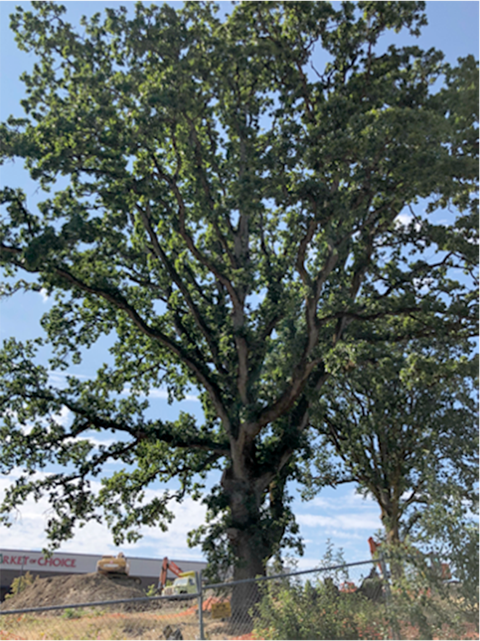Mighty oaks

By Susan Mates
Has a towering tree standing alone caught your eye? It’s likely to be an Oregon White Oak, Quercus garryana, the only oak native to this part of Oregon. Some of these slow-growing oaks may live to be 500 years old and can eventually command a space over 100 feet tall and sixty feet wide, with roots growing far beyond the boundaries of its massive branches.

Are they valuable real estate? Ask birds and other wildlife. Oregon white oaks support over 300 species of native animals and plants year-round by providing food, shelter, and good nesting habitat. Their habitat is critical for many species that are threatened, sensitive, or rare, such as the Acorn woodpecker and the native Western gray squirrel. Many mammals and birds rely on their acorns in the winter when other food is scarce, and nesting birds feed their young the insects that thrive on the oaks in the spring when native pollinators seek out their flowers.
These lovely trees can withstand drought, heavy clay soils, lengthy flooding, and damage from wind, ice, or snow, so they are able to thrive where other tree species may not. Their deep tap roots mean that Oregon white oaks are well adapted to hot, dry conditions, important considerations in today’s changing climate.
Oak savannas were once common in the Willamette Valley. Mature oaks provided abundant food for the Kalapuya Indians, who used the tree’s acorns. Oregon white oak will die once taller Douglas fir shade them, but the Kalapuya deliberately burned areas to provide food sources such as camas and to provide grazing and easy hunting for deer and elk. Mature Oregon white oaks are fire-resistant because of their thick bark, so they could withstand those low intensity grass fires. That burning, along with Oregon’s periodic natural summer wildfires, created open areas of mostly individual white oaks.
The arrival of European settlers marked the beginning of fire suppression, logging, and conversion to agriculture. Now the biodiverse habitats supported by the Oregon white oak have dwindled. Conifers like Douglas fir have encroached upon the oaks and increasing development has decimated them too. The trees cover less than five percent of their former range and are considered to be imperiled.

A recent citizen science project in the Metro area mapped the oaks by searching from aerial photographs and on the ground. This has enabled new restoration strategies and priorities, and partnerships with private landowners to conserve oak habitat.
Protecting trees like these is our mutual responsibility. We are all stakeholders in this resource and there is so much that can be accomplished if we work together. Treekeepers of Washington County is a grassroots community group whose mission is to protect existing trees in urban unincorporated areas of Washington County such as Cedar Mill. These areas do not have a tree code that protects urban trees. We hope you will visit our website to learn more, and find out how you might help. Or just enjoy our local tree walk map and see one of these majestic Oregon white oaks for yourself!





